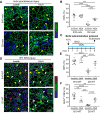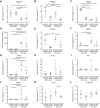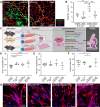Altered muscle niche contributes to myogenic deficit in the D2-mdx model of severe DMD
- PMID: 37402716
- PMCID: PMC10319851
- DOI: 10.1038/s41420-023-01503-0
Altered muscle niche contributes to myogenic deficit in the D2-mdx model of severe DMD
Abstract
Lack of dystrophin expression is the underlying genetic basis for Duchenne muscular dystrophy (DMD). However, disease severity varies between patients, based on specific genetic modifiers. D2-mdx is a model for severe DMD that exhibits exacerbated muscle degeneration and failure to regenerate even in the juvenile stage of the disease. We show that poor regeneration of juvenile D2-mdx muscles is associated with an enhanced inflammatory response to muscle damage that fails to resolve efficiently and supports the excessive accumulation of fibroadipogenic progenitors (FAPs), leading to increased fibrosis. Unexpectedly, the extent of damage and degeneration in juvenile D2-mdx muscle is significantly reduced in adults, and is associated with the restoration of the inflammatory and FAP responses to muscle injury. These improvements enhance regenerative myogenesis in the adult D2-mdx muscle, reaching levels comparable to the milder B10-mdx model of DMD. Ex vivo co-culture of healthy satellite cells (SCs) with juvenile D2-mdx FAPs reduces their fusion efficacy. Wild-type juvenile D2 mice also manifest regenerative myogenic deficit and glucocorticoid treatment improves their muscle regeneration. Our findings indicate that aberrant stromal cell responses contribute to poor regenerative myogenesis and greater muscle degeneration in juvenile D2-mdx muscles and reversal of this reduces pathology in adult D2-mdx muscle, identifying these responses as a potential therapeutic target for the treatment of DMD.
© 2023. The Author(s).
Conflict of interest statement
The authors declare no competing interests.
Figures








Update of
-
Altered muscle niche contributes to myogenic deficit in the D2- mdx model of severe DMD.bioRxiv [Preprint]. 2023 Mar 28:2023.03.27.534413. doi: 10.1101/2023.03.27.534413. bioRxiv. 2023. Update in: Cell Death Discov. 2023 Jul 4;9(1):224. doi: 10.1038/s41420-023-01503-0. PMID: 37034785 Free PMC article. Updated. Preprint.
References
Grants and funding
LinkOut - more resources
Full Text Sources
Miscellaneous

